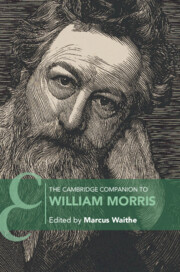Book contents
- The Cambridge Companion to William Morris
- The Cambridge Companion to William Morris
- Copyright page
- Dedication
- Contents
- Figures
- Notes on Contributors
- Acknowledgements
- Note on The Collected Works
- Chronology
- Abbreviations
- Introduction
- Part I Senses of Place
- Part II Authorship
- Part III The Practical Arts
- Chapter 12 Morris & Company
- Chapter 13 Pattern
- Chapter 14 Technologies of the Book
- Part IV Movements and Causes
- Part V Influences and Legacies
- Guide to Further Reading
- Index
- Cambridge Companions To …
Chapter 13 - Pattern
Textiles and Wallpaper
from Part III - The Practical Arts
Published online by Cambridge University Press: 03 May 2024
- The Cambridge Companion to William Morris
- The Cambridge Companion to William Morris
- Copyright page
- Dedication
- Contents
- Figures
- Notes on Contributors
- Acknowledgements
- Note on The Collected Works
- Chronology
- Abbreviations
- Introduction
- Part I Senses of Place
- Part II Authorship
- Part III The Practical Arts
- Chapter 12 Morris & Company
- Chapter 13 Pattern
- Chapter 14 Technologies of the Book
- Part IV Movements and Causes
- Part V Influences and Legacies
- Guide to Further Reading
- Index
- Cambridge Companions To …
Summary
The chapter discusses William Morris’s understanding of pattern and his designs for wallpaper and woven and printed textiles. It acknowledges his call for pattern that would be soothing and restful for the viewer. The chapter explains that, for Morris, pattern was nonetheless expected to function on an intellectual level. Good pattern could engage with personal, political and ethical issues at a level of high seriousness, he thought. Reference is made to Morris’s reading of Gottfried Semper and to Morris’s partial translation (from a French edition) of Ferdowski’s Shahnameh (c. 1010 CE) recounting pre-Islamic Persian myths. Looking at Morris’s theoretical and instructional writing and considering designs of the early 1880s such as Windrush and Strawberry Thief, the chapter explores themes of fabrication, stylisation of plant forms, cultural exchange, the ongoing redeployment of ornamental motifs and aesthetic engagement with Persian culture as well as allusions to familial and romantic love. Traits of Morris designs such as symmetrical paired figures, crossing plant stems, vertical ‘tree of life’ axes, emphatic meanders in certain designs, variations in scale and composite plant forms are investigated and interpreted. The chapter demonstrates that Morris’s designs offer evidence of his commitment to the intellectual dimensions of pattern.
- Type
- Chapter
- Information
- The Cambridge Companion to William Morris , pp. 174 - 187Publisher: Cambridge University PressPrint publication year: 2024

